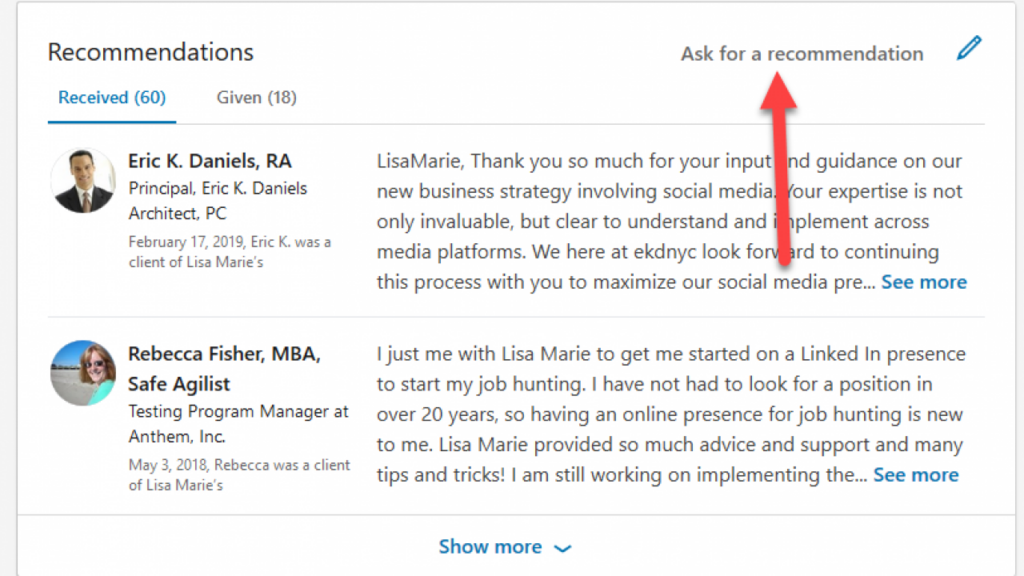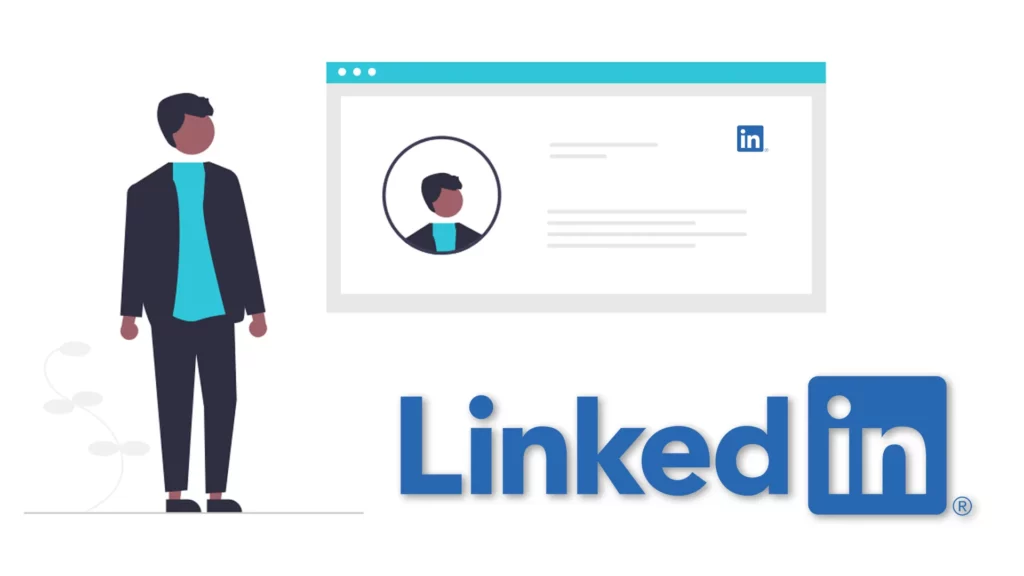A LinkedIn recommendation is a written testimonial or endorsement that one LinkedIn member writes about another member’s skills, expertise, and professional qualities. It serves as a way for colleagues, clients, supervisors, or business partners to publicly acknowledge and vouch for someone’s capabilities and accomplishments. Recommendations are displayed on a person’s LinkedIn profile and can help establish their credibility, expertise, and reputation within their professional network.
How Does A LinkedIn Recommendation Work?
When someone writes a recommendation for another LinkedIn member, they typically highlight specific projects, achievements, or qualities that make that person stand out. Recommendations can focus on various aspects, such as leadership skills, teamwork, problem-solving abilities, industry knowledge, or any other relevant strengths. They provide potential employers, recruiters, or business contacts with additional insights into a person’s professional capabilities and character.
Recommendations can be requested by sending a direct request to a LinkedIn connection. It is considered good practice to write personalized recommendations for others and to reciprocate when someone requests a recommendation from you. Quality recommendations that offer specific examples and genuine praise can significantly enhance a person’s professional reputation on LinkedIn.
Why Should I Have Recommendations On My LinkedIn Page?


There are several reasons why someone might choose to write a LinkedIn recommendation for another person. Firstly, writing a recommendation is a way to show support and appreciation for a colleague, employee, or business partner. It can strengthen professional relationships and demonstrate a willingness to help others succeed.
Some other reasons could be:
- Reciprocity: LinkedIn is a platform built on professional networking, and writing recommendations is often seen as a reciprocal gesture. When you write a recommendation for someone, they may be more inclined to write one for you in return, creating a mutually beneficial networking dynamic.
- Enhancing credibility: Recommendations contribute to a person’s credibility and reputation. When others vouch for your skills, expertise, and character, it can bolster your professional image and make you more attractive to potential employers, clients, or business partners. Think about how many times a job opportunity goes to someone else just because they have great ratings and reviews. Even when you are absolutely sure in your abilities to handle the job perfectly.
- Differentiation: In a competitive job market, recommendations can help you stand out from other candidates. Having well-written and thoughtful recommendations on your profile can provide additional evidence of your abilities and achievements beyond whatever you have mentioned in your resume or profile.
- Building a personal brand: LinkedIn recommendations can contribute to shaping your personal brand and professional narrative. They allow others to highlight your strengths, accomplishments, and unique qualities, helping you craft a compelling professional story.
- Networking and visibility: Recommendations increase your visibility within your LinkedIn network. They appear on your profile and can catch the attention of potential employers, recruiters, or collaborators who are researching your background. Positive recommendations can lead to new opportunities or connections.
Overall, writing a recommendation is a way to contribute to the professional community, showcase your support for others, and enhance your own professional brand and networking potential.
Can I Write A Recommendation For Myself?
While we do not recommend writing a recommendation for yourself, you can certainly craft a strong and compelling summary or a profile description that highlights your skills, experience, and achievements. The purpose of a LinkedIn recommendation is to have others vouch for your professional capabilities, character, and work ethic. Self-written recommendations lack the credibility and objectivity that come from external endorsements. Instead, focus on creating a well-crafted LinkedIn profile that showcases your expertise, accomplishments, and professional brand.
Here are some tips for writing a strong LinkedIn summary:
- Start with a strong opening: Capture the reader’s attention by starting with a compelling statement or a brief summary of your professional background.
- Highlight key skills and achievements: Identify your key skills, expertise, and accomplishments relevant to your field. Be specific and provide examples or quantifiable results when possible.
- Showcase your unique value proposition: What sets you apart from others in your industry? Highlight what makes you unique and why someone should choose to work with or hire you.
- Share your professional passion: Express your enthusiasm for your work and industry. Let your passion shine through in your summary, demonstrating your dedication and commitment.
- Use a conversational tone: Write in a friendly and approachable manner, making your summary easy to read and engaging for the reader.
- Include a call to action: Encourage the reader to take the next step, such as connecting with you, reaching out for collaboration, or exploring opportunities to work together.
Keep your profile up to date and continuously seek recommendations from colleagues, clients, or supervisors who can provide objective and authentic endorsements of your skills and professional qualities.
What To Consider When Writing A Recommendation


When writing a LinkedIn recommendation for someone, there are several important factors to consider. Here are some key things to keep in mind:
- Be specific: Provide specific examples of the person’s accomplishments, skills, and qualities. Share anecdotes or projects where they excelled and highlight their specific contributions. Generic or vague statements don’t carry as much weight.
- Focus on relevant strengths: Tailor your recommendation to the person’s professional goals or the specific skills they want to highlight. Consider what sets them apart in their field or industry and emphasize those strengths.
- Be authentic and sincere: Write from the heart and genuinely express your appreciation for the person’s abilities and character. Authentic recommendations carry more weight and therefore, are more likely to be valued by potential clients.
- Provide a balanced perspective: While it’s important to highlight the person’s strengths, also acknowledge areas where they have shown growth or improvement. A well-rounded recommendation provides a more accurate and trustworthy assessment.
For the technical aspects:
- Use a professional tone: LinkedIn is a professional platform, so maintain a tone that is respectful, polished, and appropriate for the context. Avoid overly casual or informal language.
- Keep it concise: Aim for a concise recommendation that gets to the point. Focus on the most important aspects and avoid unnecessary repetition or excessive detail.
- Proofread and edit: Take the time to proofread your recommendation for grammar, spelling, and clarity. A well-written and error-free recommendation reflects positively on both you and the person you are recommending.
- Seek permission: It’s considerate to ask the person for permission before writing a recommendation for them. They may have specific preferences or additional information they want you to include.
- Respect privacy and confidentiality: Ensure that you are not revealing sensitive or confidential information in your recommendation without proper authorization. Respect the person’s privacy and professional boundaries.
- Be mindful of diversity and inclusion: Consider the importance of diversity and inclusion in your recommendation. Highlight diverse perspectives, experiences, and qualities that contribute to a more inclusive and equitable workplace.
Examples of LinkedIn recommendations For Different Job Positions:


For a Project Manager:
“I had the pleasure of working with [Name] as our project manager, and I cannot recommend [him/her] highly enough. [Name] consistently demonstrated exceptional organizational skills, attention to detail, and a keen ability to keep our complex projects on track. [They] effectively coordinated cross-functional teams, ensured clear communication among stakeholders, and adeptly managed project timelines and budgets. [Name]’s leadership and problem-solving skills were instrumental in successfully delivering multiple projects on time and within scope. [They] are a true professional who brings dedication, expertise, and a positive attitude to every endeavor. Any team or organization would greatly benefit from [their] contributions.”
For a Sales Representative:
“I have had the pleasure of working closely with [Name] for the past two years, and I am consistently impressed by [his/her] sales prowess and ability to deliver outstanding results. [Name] is a natural relationship builder with exceptional communication skills. [They] effortlessly connect with clients, understand their needs, and craft tailored solutions that consistently exceed expectations. [Their] unwavering dedication, resilience, and strategic thinking have consistently driven revenue growth and customer satisfaction. [Name] is a true asset to any sales team and has my highest recommendation.”
For a Software Engineer:
“[Name] is an exceptionally talented software engineer who consistently delivers high-quality code and innovative solutions. I had the privilege of working with [them] on a complex software development project, and [they] demonstrated an impressive mastery of programming languages and frameworks. [Name]’s problem-solving abilities and attention to detail ensured that our software performed flawlessly, and [they] were always ready to lend a hand and collaborate with the team. [Their] passion for technology and commitment to staying up-to-date with the latest industry trends is evident in [their] work. I would not hesitate to work with [Name] again and wholeheartedly recommend [them] to any organization seeking a top-notch software engineer.”
For a graphic designer or any job in the world of digital art:
“I had the pleasure of collaborating with [Name] on several design projects, and I am continually impressed by [his/her] exceptional creativity and artistic talent. [Name] has a unique ability to bring ideas to life through captivating visuals that surpass expectations. [they] possess a keen eye for detail, ensuring that every element of [their] designs is meticulously crafted. [Name]’s versatility across different mediums and design software is remarkable, allowing [him/her] to adapt to various project requirements with ease.
Beyond [their] technical skills, [Name] is an outstanding communicator and collaborator. [They] actively listens to client briefs, grasping the essence of their vision, and translating it into visually stunning designs. [Their] ability to incorporate feedback and iterate on designs exemplifies [their] dedication to delivering exceptional results.
Throughout our collaboration, I witnessed [Name]’s ability to meet deadlines without compromising on quality. [They] approach each project with a strong work ethic, a passion for excellence, and a genuine enthusiasm for bringing concepts to life. [Name]’s designs not only engage the audience but also effectively convey the desired message.
I highly recommend [Name] to anyone seeking a talented graphic designer/artist who can elevate their brand and create impactful visuals. [Their] combination of artistic talent, technical expertise, and collaborative nature make [them] an invaluable asset to any creative team.”
Note:
These examples illustrate the structure and content of LinkedIn recommendations for different job positions. Remember to tailor your recommendation based on your personal experience with the individual and highlight specific projects or qualities that make them stand out as a graphic designer/artist.
Potential Risks Of Self-Written Recommendations:


Self-written recommendations on LinkedIn can carry certain risks and drawbacks. Self-written recommendations lack the objectivity and credibility that come from external endorsements. LinkedIn recommendations are generally perceived as more genuine and trustworthy when they are written by others who have worked with or experienced the person’s skills firsthand.
Writing a recommendation for yourself is frankly, a deceptive and unethical practice. LinkedIn is a platform for authentic professional connections and endorsements. Self-promoting is generally discouraged, as goes against the spirit of genuine recommendations and can undermine trust within your network.
Some other reasons why self-written recommendations can damage your reputation include:
- You might be perceived as boastful: Self-written recommendations can come across as self-promotion or boasting. It may create an impression that you are not humble or that you are trying too hard to build your professional image. Even if you are being honest, nobody would want to work with you.
- Lack of perspective: When writing your own recommendation, it’s challenging to gain the necessary distance to provide a balanced and objective perspective on your skills and achievements. External recommendations often provide insights and viewpoints that you may overlook or not fully recognize about yourself.
- Potential backlash: If others in your professional network discover that you have written self-recommendations, it may damage your reputation and credibility. It can be seen as an attempt to manipulate your image or deceive others.
- Missed networking opportunities: Writing recommendations for others allows you to engage in professional networking and build strong relationships. By focusing solely on self-written recommendations, you may miss out on the opportunity to connect and collaborate with others in your industry.
Note:
Avoid self recommendations simply because one way or another, you are going to have a job beyond your skill set, and it will come bite your.. back. Trust us!
Instead of writing self-recommendations, focus on building a strong profile, showcasing your skills, experience, and achievements in a genuine and transparent manner. Seek recommendations from colleagues, clients, or supervisors who can provide objective assessments of your abilities and character. This approach will help you build a more credible and robust professional network.
How To Ask A Client For A Recommendation
When asking past clients to leave a recommendation on LinkedIn, it’s important to approach them professionally and make the process as easy as possible for them. Here are some steps to consider:
- Choose the right clients: Select clients with whom you had a positive and successful working relationship. Focus on those who can provide meaningful insights into your skills, expertise, and the value you delivered.
- Personalize your request: Take the time to craft personalized messages for each client rather than using a generic template. Mention specific projects or achievements you worked on together to jog their memory and make the request more meaningful.
- Remind them of the value you provided: Briefly summarize the work you did for them and how it made a positive impact. Remind them of the results or benefits they obtained from your services.
- Explain the importance of LinkedIn recommendations: Briefly explain the significance of LinkedIn recommendations and how they can help showcase your skills and expertise to potential clients or employers. Mention that their recommendation will be publicly displayed on your profile, contributing to your professional reputation.
- Express gratitude: Thank them for their time and consideration in leaving a recommendation. Let them know that you genuinely appreciate their support.
- Follow up: If you don’t receive a response within a reasonable timeframe, consider sending a polite follow-up message as a gentle reminder. However, be mindful not to pester or pressure them.
Make it easy!
Provide clear instructions on how to leave a recommendation on LinkedIn. You can direct them to the “Recommendations” section on your profile and explain that they can click on the “Ask for a recommendation” button to start writing. Offer to provide any assistance or answer any questions they may have.
Remember to be professional, respectful, and appreciative throughout the process. It’s important to respect their decision if they choose not to leave a recommendation. Building and maintaining positive relationships with your clients is the key. So the recommendations should be sought in a manner that preserves those relationships.





















Leave a Reply
View Comments